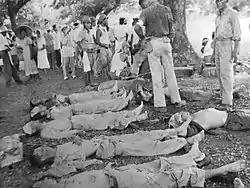Pantingan River massacre
The Pantingan River massacre (Filipino: Pagpatay sa Ilog Pantingan) took place during the Bataan Death March in mid-April 1942. Several hundred soldiers from the Philippine Commonwealth Army's 1st, 11th, 71st, and 91st Divisions on the march to the north of Mount Samat where the Pantingan River crosses the Pilar-Bagac Road were taken to the riverside. Most of them were shot, bayoneted or beheaded by the Imperial Japanese Army.[1]
| Pantingan River massacre | |
|---|---|
 Some of the dead soldiers during the Bataan Death March | |
| Location | Bataan, Luzon, Philippines |
| Date | 1942 (EDT) |
Attack type | massacre |
| Deaths | Several hundred |
| Perpetrators | Imperial Japanese Army |
The atrocity was attributed to Japanese Colonel Masanobu Tsuji. Following Tsuji's abnormal order which was considered to be a war crime and beyond his commission, Japanese 122 Regiment of Sixty-fifth Brigade executed the US and Philippine soldiers in the Pantingan River.[2] Colonel Takeo Imai, of another Japanese regiment, doubted the authority of the order which came from the top but not clearly from who ? Imai ignored the cruel order and did not execute anyone.[3][4]
Survivors of the massacre include Lt. Manuel Yan who later became the head of the Armed Forces of the Philippines and ambassador to Thailand. Another survivor, Capt. Ricardo Papa, a G-3 Officer of the 91st Division later became a Chief of Police in Manila.[5]
See also
- Battle of the Philippines (1941–42)
References
- Mariano Villarin, We remember Bataan and Corregidor: the story of the American & Filipino defenders of Bataan and Corregidor and their captivity (Gateway Press, 1990), 176.
- Norman, Michael & Norman, Elizabeth (2009-06-09). Tears in the Darkness (revised ed.). Farrar, Straus and Giroux. ISBN 978-0374272609 / Mr.Imai Takeo "Shinajihen No Kaisou" (in Japanese) P.178-180
- Mr.Imai Takeo "Shinajihen No Kaisou" (in Japanese) P.178-180
- Nelson, Jim. "The Causes of the Bataan Death March Revisited". The US-Japan Dialogue on POWs. Retrieved 24 April 2020.
- Leocadio De Asis, The Thread of Fate: A Personal Story in Philippine-Japanese Relations (Makati, Metro Manila, Philippines: Philippine Foundation of Japan Alumni, 1986)., 16.